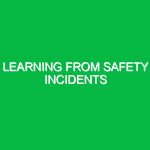Understanding Incident Learning and Sharing
Incident Learning and Sharing is a crucial process within the Health, Safety, and Environment (HSE) domain aimed at improving workplace safety and fostering a culture of continuous learning. At its core, this concept revolves around analyzing safety incidents—be they near misses, non-compliance events, or actual accidents—and disseminating the insights gained across the organization. The primary objective is to prevent recurrence of similar incidents by understanding their root causes and implementing corrective actions. In an environment where safety is paramount, effective incident learning can save lives and reduce operational disruptions.
Many organizations have recognized that sharing knowledge gleaned from incidents not only enhances safety protocols but also encourages a proactive approach to risk management. For instance, when a manufacturing facility experiences a near miss involving machinery, documenting and sharing the details of that incident can prompt other teams to reevaluate their safety measures, potentially averting a future mishap. This ripple effect of knowledge is what makes Incident Learning and Sharing so vital within HSE contexts.
Potential Hazards and Risks Associated with Incident Learning and Sharing
Identifying All Hazards
While the process of Incident Learning and Sharing is designed to mitigate risks, it is not without its own potential hazards. Miscommunication, inadequate documentation, and a lack of follow-up on shared learning can lead to significant challenges. For instance, if an incident report is poorly written or lacks essential details, it can result in misunderstandings or misinterpretations of the lessons learned. This can ultimately undermine the safety efforts of the organization.
Additionally, there is the risk of complacency. If employees believe that merely sharing incidents is sufficient for ensuring safety, they may neglect to implement the necessary changes to prevent future occurrences. Furthermore, organizations must navigate the psychological and social dynamics that come into play when discussing incidents. Employees may feel reluctant to report incidents due to fear of repercussions, which can lead to underreporting and a skewed understanding of actual safety performance.
Complexities in Risk Management
Another layer of complexity arises from the diverse nature of incidents across various sectors. In construction, for instance, the hazards may include falls from heights or equipment-related injuries, while in healthcare, risks might stem from infection control or patient handling. Each sector has its unique challenges, which necessitates tailored approaches to incident learning and sharing. A one-size-fits-all strategy simply won’t suffice.
Best Practices and Safety Precautions
Implementing Effective Incident Reporting Systems
To facilitate robust Incident Learning and Sharing, organizations must establish effective incident reporting systems. This begins with developing a clear, user-friendly reporting process. Employees should feel empowered to report incidents without fear of punishment. Encouraging a blame-free culture can foster open communication and honest reporting. For example, the oil and gas industry often uses anonymous reporting systems to ensure that all incidents, no matter how minor, are documented and analyzed.
Furthermore, organizations should train their employees on how to properly report incidents. This training should cover what details are necessary for a comprehensive report, including the who, what, where, when, and why of the incident. By standardizing reporting procedures, organizations can ensure that all relevant information is collected and can be useful for future analysis.
Regular Training and Workshops
Training is vital for both understanding the importance of incident learning and for implementing the findings effectively. Regular workshops can be organized to discuss recent incidents, analyze what went wrong, and brainstorm preventive measures. These sessions should be inclusive, allowing contributions from all levels of personnel. Real-life examples can be shared to highlight the importance of learning from past mistakes. For instance, a construction firm might highlight a near miss involving scaffolding to emphasize the importance of following safety protocols.
Creating a Centralized Knowledge Base
Another best practice is to create a centralized knowledge base where all incident reports and learnings are stored and easily accessible. This database should be regularly updated and categorized according to various factors, such as type of incident, department, or severity. This not only aids in quick retrieval of information but also helps in identifying patterns over time. For instance, if multiple incidents concerning electrical safety are reported, it may signal a need for more focused training in that area.
Regulatory Framework Governing Incident Learning and Sharing
The landscape of Incident Learning and Sharing is also shaped by various regulations and standards. Compliance with these guidelines is essential for ensuring safety and promoting a culture of learning. Key regulations include:
- Occupational Safety and Health Administration (OSHA): OSHA mandates the reporting of certain incidents and requires employers to maintain records of work-related injuries and illnesses.
- ISO 45001: This international standard outlines requirements for occupational health and safety management systems, emphasizing the need for continuous improvement, including learning from incidents.
- Environmental Protection Agency (EPA): The EPA‘s regulations may also influence incident reporting, particularly in industries that deal with hazardous materials.
Organizations should not only comply with these regulations but also strive to exceed them, viewing compliance as a baseline rather than a goal. Engaging with regulatory bodies can provide additional insights into best practices and emerging trends in incident learning and management.
Conclusion
Incident Learning and Sharing represents a powerful tool within the HSE domain, enabling organizations to learn from past experiences and enhance their safety protocols. By effectively identifying potential hazards, implementing best practices, and adhering to regulatory standards, businesses can create a safer work environment. The journey towards a culture of safety is ongoing. Organizations must remain vigilant, continually refining their incident learning processes to adapt to new challenges and ensure the well-being of their workforce.
In the end, the true measure of an organization’s commitment to health and safety lies not only in its ability to prevent incidents but also in its willingness to learn from them. Embracing a culture of incident learning can pave the way for innovations in safety practices, ultimately leading to a safer and more productive workplace.


